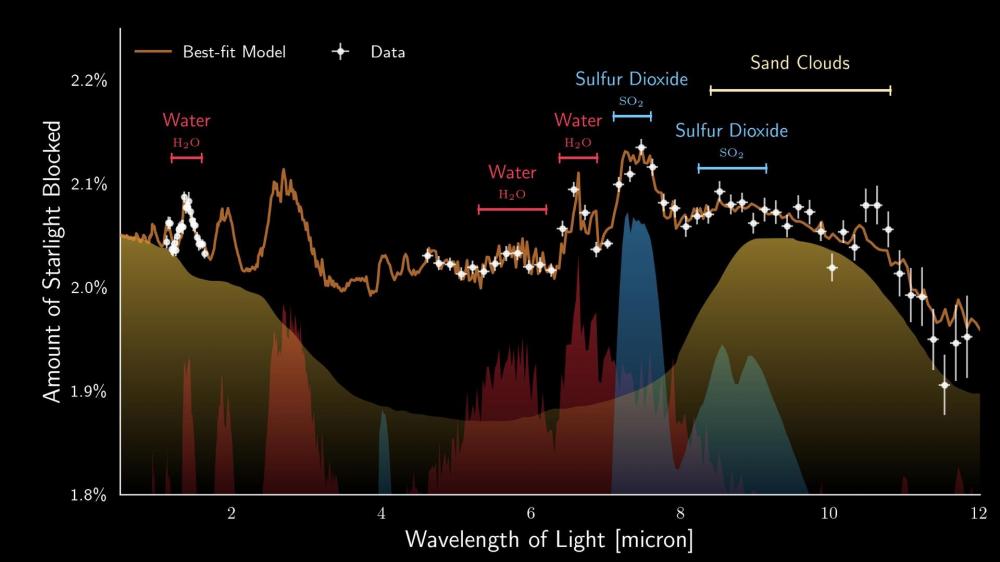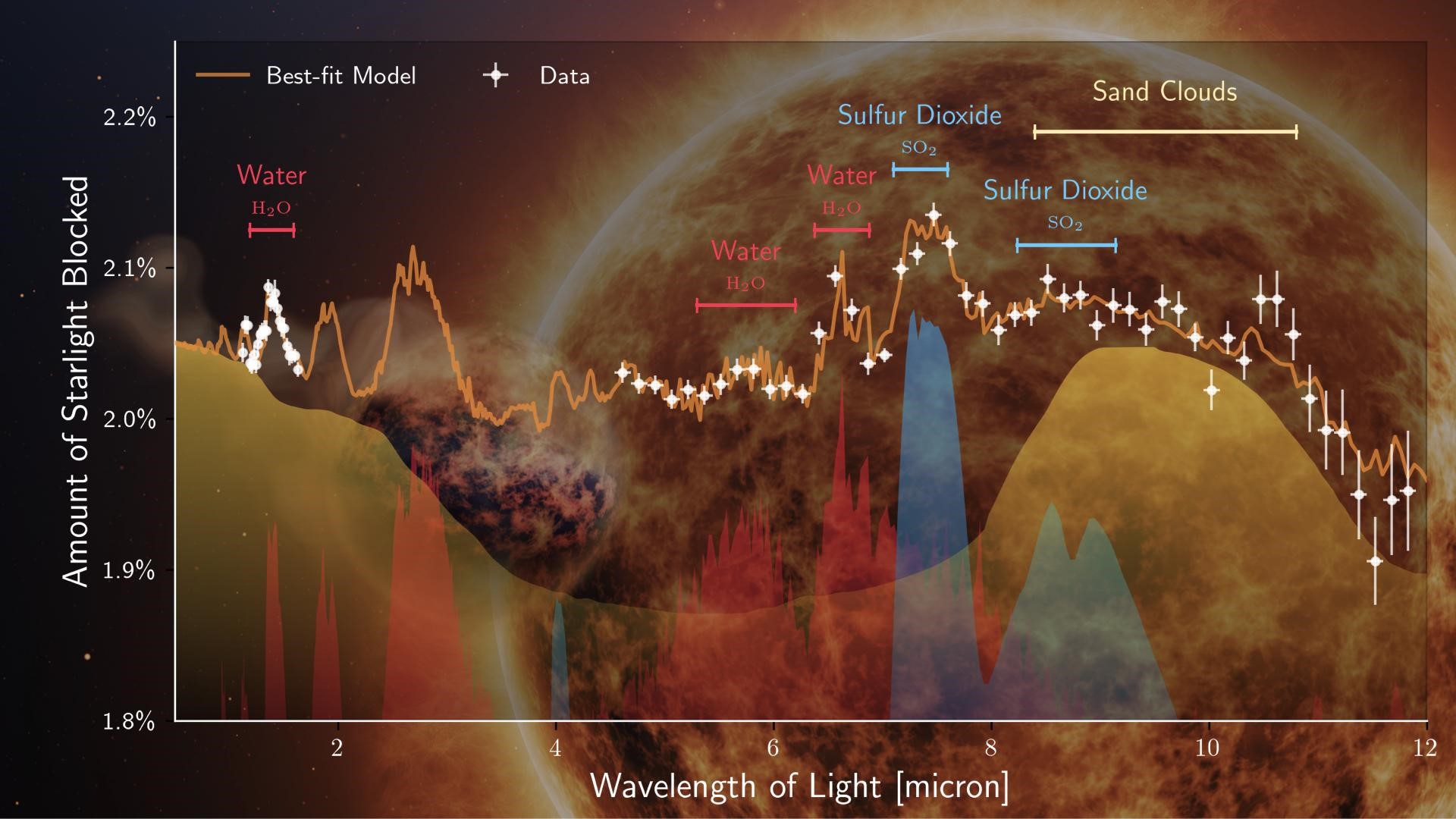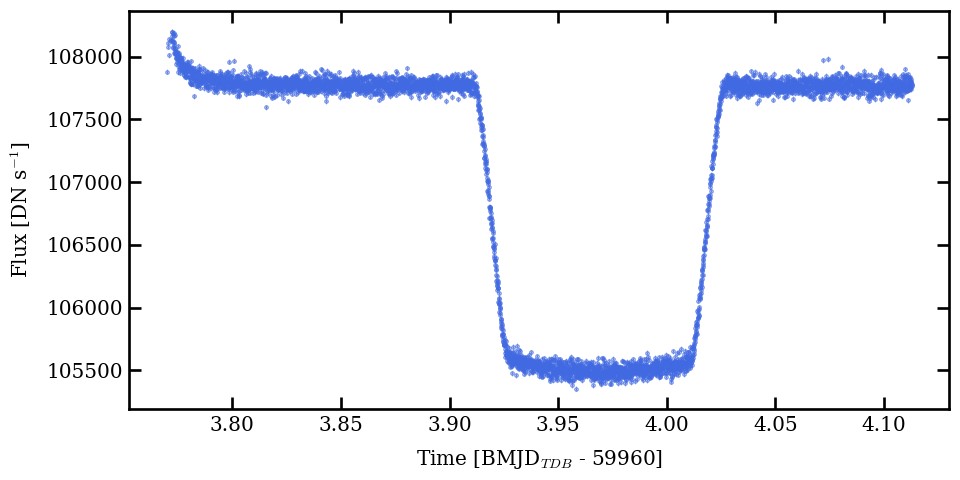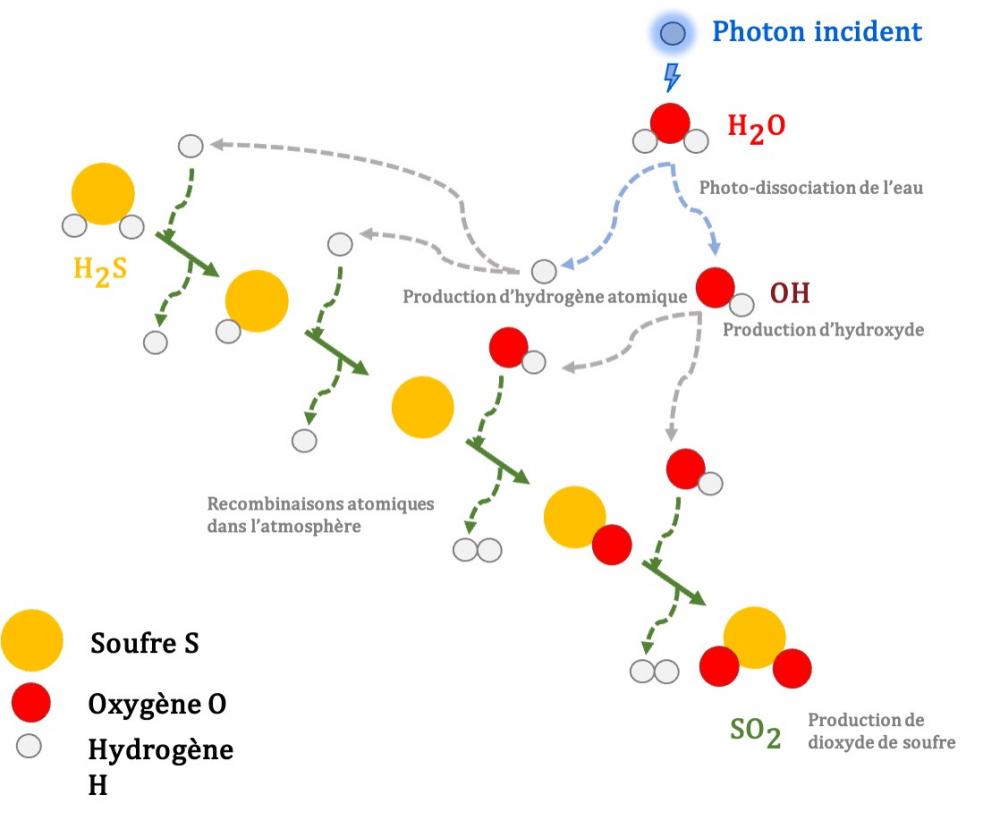
Atmospheric composition of WASP-107b obtained using MIRI's LRS low-resolution spectrometer. The data are complemented by Hubble data, taken on June 5 and 6, 2017, between 1.1 and 1.7 microns. The colored spectral bands at the bottom of the image represent the characteristic bands of the molecules detected: red is water vapor (H20), blue is sulfur dioxide (S02) and yellow is the silicate continuum (Si02). The best atmospheric model representative of MIRI observations (white dots) is shown in orange.
Credits: Michiel Min / European MIRI EXO GTO team / ESA / NASA
An international team of scientists, led by the Astrophysics Department of the CEA, has observed for the first time the swollen atmosphere of the exoplanet WASP-107b in the mid-infrared using the James Webb Space Telescope.
While water vapor has indeed been detected, it is accompanied by sulfur dioxide (SO2) and silicate clouds (resembling sand clouds), rather than methane (CH4) as models predicted. The detection of sulfur dioxide can be explained by photochemical reactions in the very high atmosphere due to the intense irradiation by photons from the star. This is because the planet is extremely close to its star, completing an orbit around it in just five days. The absence of methane is currently unexplained and will require a rethinking of models, including the physical and chemical mechanisms at work in this atmosphere. The detection of silicate clouds in a low-mass planet like Neptune is a first!
These findings show that, while the planetary environment, especially the irradiation from its star, matters, considering the dynamics of the atmosphere will become increasingly indispensable for understanding exoplanetary atmospheres.
The results of the study are published in the journal Nature: Dyrek, A., Min, M., Decin, L. et al. "SO2, silicate clouds, but no CH4 detected in a warm Neptune" (2023).
To date, scientists have identified over 5000 exoplanets, which exhibit extreme diversity and often differ significantly from those in our Solar System. New worlds are coming within the reach of telescopes. By studying their atmospheres, researchers seek to address major questions that captivate the scientific community:
- What are the physical and chemical processes governing the composition of atmospheres?
- What is the impact of the star-planet interaction on the evolution of atmospheres? On their habitability?
JWST on the Quest for Exoplanet Atmospheres
The study of systems is conducted by observing the thin atmospheric layer around the exoplanet when it transits between its star and the telescope's line of sight. This phenomenon is known as a transit. The signal corresponding to this atmosphere is very faint, ranging between 0.1 and 1% of the brightness of the host star (L ?), making molecular detections extremely challenging. In fact, the only molecule detected by the Hubble Space Telescope (HST/NASA) was water in gaseous form. To delve deeper, an observatory with the sensitivity, spectral resolution, and wavelength coverage needed to detect other valuable molecules was required. Launched two years ago, the James Webb Space Telescope (JWST - NASA/ESA/CSA), the largest space observatory ever built, has already achieved milestones by detecting molecules such as CO2, NH3, and SO2.
WASP-107b: A Singular Exoplanet
WASP-107b is a unique gas giant exoplanet, a super-Neptune, distinguished by its Neptune-like mass but Jupiter-sized radius. Its atmosphere is highly inflated, and it completes an orbit around its star in just 5 days, experiencing extreme irradiation conditions compared to planets in our Solar System. The inflated nature of this exoplanet allows astronomers to explore its atmosphere in greater detail than they could with a giant in our solar system like Jupiter.
It serves as an ideal laboratory to probe the chemical elements that make up the layers of its atmosphere.
Animation of WASP-107b transiting its host star
Credits: Illustration: LUCA School of Arts, Belgium/ Klaas Verpoest (visuals), Johan Van Looveren (typography). Science: Achrène Dyrek (CEA and Université Paris Cité, France), Michiel Min (SRON, the Netherlands), Leen Decin (KU Leuven, Belgium) / European MIRI EXO GTO team / ESA / NASA
Scientists observed the transit of exoplanet WASP-107b in front of its star for 8 hours (between 2 and 3 hours of primary transit) to determine the chemical composition of its atmosphere using the Low-Resolution Spectrometer (LRS) of MIRI.
Interpretation of Data
Scientists monitor the passage of a planet in front of its star and break down the transit light through spectroscopy, allowing them to obtain multiple light curves (transit curve) at different wavelengths.
The depth of the transit varies depending on the chemical composition of the atmosphere and the absorption of molecules present, hence the wavelength. Each molecule absorbs at a specific wavelength, giving it a unique fingerprint. When probing the atmosphere at the appropriate wavelength, the molecule will either block or allow the star's radiation to pass through. If the radiation is blocked, the star's light cannot reach us, making the planet appear larger (i.e., the transit is deeper), and vice versa.
To interpret the curves obtained, theoretical models of planetary formation are required. For each model, researchers calculate the electromagnetic spectrum it should produce by testing different chemical elements, then compare it with observations.

The data results (white dot) and the best theoretical model fit (orange curve), all sperposed with the artist's image of super-Neptune WASP-107b. Credits illustration: @Michiel Min / European MIRI EXO GTO team / ESA / NASA; @Klaas Verpoest (LUCA School of Arts, Belgium)
Results
Theoretical models predicted for this relatively "cool" exoplanet (700K) the detection of sulfur in the form of H2S (hydrogen sulfide), methane, and water vapor. However, scientists discovered the presence of sulfur dioxide (SO2), silicate clouds (or sand), water in vapor form, and no methane!
The observational capability to affirm the absence of methane places significant constraints on the models, necessitating the development of new scenarios.
Similarly, the detection of sulfur dioxide (SO2) and the absence of hydrogen sulfide (H2S) indicate photodissociation reactions of gaseous water in the upper atmosphere and the recombination of hydrogen with H2S to form SO2. These processes involve chemical reactions initiated by energetic stellar light.
The star's environment is crucial, considering both its irradiation and the dynamic movements within the atmosphere. These processes need to be incorporated into models for this exoplanet. An atmosphere is dynamic!
What happens next?
To continue interpreting the data from these WASP-107b transits and further constrain the models, the scientists will be gathering additional data with other existing (but not yet published) observations from the other JWST instruments operating at wavelengths of 0.6 to 5 microns, to find out whether the molecules detected by MIRI (4.61 and 11.83 microns) are also detected at lower wavelengths. Stay tuned for the second article....
Contacts DAp: Achrène DYREK, Pierre-Olivier LAGAGE
- article: Dyrek, A., Min, M., Decin, L. et al. "SO2, silicate clouds, but no CH4 detected in a warm Neptune". Nature (2023). https://doi.org/10.1038/s41586-023-06849-0
- News site JWST.fr
- News Institute of Astronomy de Leuven (kuleuven.be)





